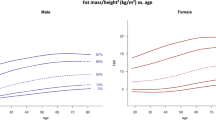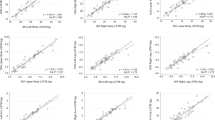Abstract
Background/Objectives
Dual-energy X-ray absorptiometry (DXA) is becoming a method of choice for the assessment of visceral adipose tissue (VAT) but the lack of robust reference ranges presents a challenge to the interpretation of VAT in clinical practice, research settings, and the athletic environment. The objective of this study was to develop age- and sex-specific reference intervals for DXA-derived VAT mass.
Subjects/Methods
The reference group comprised 3219 adults (1886 general population, 42% women; 1333 athletes, 11% women) in the United Kingdom, aged 18–83 years. Total body scans were performed using a GE Lunar iDXA and VAT analyses were enabled through Corescan software (Encore version 15.0). Age-specific reference ranges were derived in samples stratified by sex and general population/ athlete status. We modelled the mean and SD of Box-Cox transformed VAT mass as a function of age with a generalised least squares method using fractional polynomials (Stata® -xrigls- program). Centile values were then back-transformed to provide reference intervals on the original scale.
Results
In general population samples, average VAT mass increases with age up until around 65–70 years, and then begins to decline at older ages, though data are relatively sparse at the upper end of the age range. In athletes, on average, VAT mass increases with advancing age in men and women. Both 95 and 98% reference ranges are presented in 5-year increments in all samples, and we provide equations to enable the calculation of any centile, for any age within the range.
Conclusions
These reference data can aid the interpretation of VAT mass specific to an individual’s sex, age, and athletic status, increasing the utility and applicability of DXA-derived VAT assessments. Additional research is needed in adults over 65 years and female athletes, with different DXA devices, across different ethnic groups and specific sports.
This is a preview of subscription content, access via your institution
Access options
Subscribe to this journal
Receive 12 print issues and online access
$259.00 per year
only $21.58 per issue
Buy this article
- Purchase on Springer Link
- Instant access to full article PDF
Prices may be subject to local taxes which are calculated during checkout
Similar content being viewed by others
References
Fontana L, Eagon JC, Trujillo ME, Scherer PE, Klein S. Visceral fat adipokine secretion is associated with systemic inflammation in obese humans. Diabetes. 2007;56:1010–3.
Després J-P. Body fat distribution and risk of cardiovascular disease: an update. Circulation. 2012;126:1301–13.
Britton KA, Massaro JM, Murabito JM, Kreger BE, Hoffmann U, Fox CS. Body fat distribution, incident cardiovascular disease, cancer, and all-cause mortality. J Am Coll Cardiol. 2013;62:921–5.
Hind K, Pearce M, Birrell F. Total and visceral adiposity are associated with prevalent vertebral fracture in women but not men at age 62 years: the Newcastle Thousand Families Study. J Bone Miner Res. 2017;32:1109–15.
Kuk JL, Katzmarzyk PT, Nichaman MZ, Church TS, Blair SN, Ross R. Visceral fat is an independent predictor of all-cause mortality in men. Obesity. 2006;14:336–41.
Kaul S, Rothney MP, Peters DM, Wacker WK, Davis CE, Shapiro MD, et al. Dual-energy X-ray absorptiometry for quantification of visceral fat. Obesity. 2012;20:1313–8.
Rothney MP, Xia Y, Wacker WK, Martin F-P, Beaumont M, Rezzi S, et al. Precision of a new tool to measure visceral adipose tissue (VAT) using dual-energy X-ray absorptiometry (DXA). Obesity. 2013;21:E134–6.
Mellis MG, Oldroyd B, Hind K. In vivo precision of the GE Lunar iDXA for the measurement of visceral adipose tissue in adults: the influence of body mass index. Eur J Clin Nutr. 2014;68:1365–7.
Carver TE, Court O, Christou NV, Reid RER, Andersen RE. Precision of the iDXA for visceral adipose tissue measurement in severely obese patients. Med Sci Sports Exerc. 2014;46:1462–5.
Miazgowski T, Krzyżanowska-Świniarska B, Dziwura-Ogonowska J, Widecka K. The associations between cardiometabolic risk factors and visceral fat measured by a new dual-energy X-ray absorptiometry-derived method in lean healthy Caucasian women. Endocrine. 2014;47:500–5.
Rothney MP, Catapano AL, Xia J, Wacker WK, Tidone C, Grigore L, et al. Abdominal visceral fat measurement using dual-energy X-ray: association with cardiometabolic risk factors. Obesity. 2013;21:1798–802.
Katzmarzyk PT, Greenway FL, Heymsfield SB, Bouchard C. Clinical utility and reproducibility of visceral adipose tissue measurements derived from dual-energy X-ray absorptiometry in White and African American adults. Obesity. 2013;21:2221–4.
Neeland IJ, Grundy SM, Li X, Adams-Huet B, Vega GL. Comparison of visceral fat mass measurement by dual-X-ray absorptiometry and magnetic resonance imaging in a multiethnic cohort: the Dallas Heart Study. Nutr Diabetes. 2016;6:e221.
Micklesfield LK, Goedecke JH, Punyanitya M, Wilson KE, Kelly TL. Dual-energy X-ray performs as well as clinical computed tomography for the measurement of visceral fat. Obesity. 2012;20:1109–14.
Miazgowski T, Kucharski R, Sołtysiak M, Taszarek A, Miazgowski B, Widecka K. Visceral fat reference values derived from healthy European men and women aged 20-30 years using GE Healthcare dual-energy x-ray absorptiometry. PLoS ONE. 2017;12:e0180614.
National Center for Health Statistics. NHANES 2015-2016 Body Composition Procedures Manual [Internet]. 2016 [cited 2018 Dec 21]. Available from: https://wwwn.cdc.gov/nchs/data/nhanes/2015-2016/manuals/2016_Body_Composition_Procedures_Manual.pdf
Reinhardt M, Piaggi P, DeMers B, Trinidad C, Krakoff J. Cross calibration of two dual-energy X-ray densitometers and comparison of visceral adipose tissue measurements by iDXA and MRI. Obesity. 2017;25:332–7.
Bi X, Seabolt L, Shibao C, Buchowski M, Kang H, Keil CD, et al. DXA-measured visceral adipose tissue predicts impaired glucose tolerance and metabolic syndrome in obese Caucasian and African-American women. Eur J Clin Nutr. 2015;69:329–36.
Wright EM, Royston P. Simplified estimation of age-specific reference intervals for skewed data. Stat Med. 1997;16:2785–803.
Royston P, Wright E XRIGLS: Stata module to calculate reference intervals via generalised least squares [Internet]. 2008 [cited 2018 Nov 20]. Available from: https://econpapers.repec.org/software/bocbocode/s409901.htm
Murtaugh PA. In defense of P values. Ecology. 2014;95:611–7.
Hopkins WG, Marshall SW, Batterham AM, Hanin J. Progressive statistics for studies in sports medicine and exercise science. Med Sci Sport Exerc. 2009;41:3–13.
Bellera CA, Hanley JA. A method is presented to plan the required sample size when estimating regression-based reference limits. J Clin Epidemiol. 2007;60:610–5.
Tchernof A, Després J-P. Pathophysiology of human visceral obesity: an update. Physiol Rev. 2013;93:359–404.
Hunter GR, Gower BA, Kane BL. Age related shift in visceral fat. Int J Body Compos Res. 2010;8:103–8.
Ilich JZ, Kelly OJ, Inglis JE. Osteosarcopenic obesity syndrome: what is it and how can it be identified and diagnosed? Curr Gerontol Geriatr Res. 2016;2016:1–7.
Ilich JZ, Kelly OJ, Inglis JE, Panton LB, Duque G, Ormsbee MJ. Interrelationship among muscle, fat, and bone: connecting the dots on cellular, hormonal, and whole body levels. Ageing Res Rev. 2014;15:51–60.
Mitchell JH, Haskell W, Snell P, Van Camp SP. Task force 8: classification of sports. J Am Coll Cardiol. 2005;45:1364–7.
Sasai H, Brychta RJ, Wood RP, Rothney MP, Zhao X, Skarulis MC, et al. Does visceral fat estimated by dual-energy X-ray absorptiometry independently predict cardiometabolic risks in adults? J Diabetes Sci Technol. 2015;9:917–24.
Altman DG, Bland JM. Statistics Notes: Detecting skewness from summary information. BMJ. 1996;313:1200.
Banerji MA, Faridi N, Atluri R, Chaiken RL, Lebovitz HE. Body composition, visceral fat, leptin, and insulin resistance in Asian Indian men. J Clin Endocrinol Metab. 1999;84:137–44.
Lim U, Ernst T, Buchthal SD, Latch M, Albright CL, Wilkens LR, et al. Asian women have greater abdominal and visceral adiposity than Caucasian women with similar body mass index. Nutr Diabetes. 2011;1:e6.
Wright EM, Royston P. A Comparison of Statistical Methods for Age-related Reference Intervals. J R Stat Soc. 1997;160:47–69.
Silverwood RJ, Cole TJ. Statistical methods for constructing gestational age-related reference intervals and centile charts for fetal size. Ultrasound Obstet Gynecol. 2007;29:6–13.
Fan B, Wilson J, Shepherd J, Wu X. How comparable are hologic and GE-lunar visceral fat analyses? J Clin Densitom. 2013;16:263.
Ergun DL, Rothney MP, Oates MK, Xia Y, Wacker WK, Binkley NC. Visceral adipose tissue quantification using lunar prodigy. J Clin Densitom. 2013;16:75–8.
Acknowledgements
Thank you to the current and former DXA technicians, B Oldroyd, Z Rutherford, M Barlow, M Butterworth, M Lees, L Gannon, E Payne, L Gallagher, M Marwood, L Duffield, and E Whatley at, or previously based at Leeds Beckett University who contributed to the data included in this study. Additional thanks to Arnaud Lehnisch (GE Europe) for providing technical information from GE engineering.
Author information
Authors and Affiliations
Corresponding author
Ethics declarations
Conflict of interest
The authors declare that they have no conflict of interest.
Additional information
Publisher’s note: Springer Nature remains neutral with regard to jurisdictional claims in published maps and institutional affiliations.
Supplementary information
Rights and permissions
About this article
Cite this article
Swainson, M.G., Batterham, A.M. & Hind, K. Age- and sex-specific reference intervals for visceral fat mass in adults. Int J Obes 44, 289–296 (2020). https://doi.org/10.1038/s41366-019-0393-1
Received:
Revised:
Accepted:
Published:
Issue Date:
DOI: https://doi.org/10.1038/s41366-019-0393-1
This article is cited by
-
Identifying behavioural barriers and facilitators to engaging men in a community-based lifestyle intervention to improve physical and mental health and well-being
International Journal of Behavioral Nutrition and Physical Activity (2023)
-
The triglyceride glucose-body mass index: a non-invasive index that identifies non-alcoholic fatty liver disease in the general Japanese population
Journal of Translational Medicine (2022)
-
Can visceral adipose tissue and skeletal muscle predict recurrence of newly diagnosed Crohn’s disease in different treatments
BMC Gastroenterology (2022)
-
Equations for predicting DXA-measured visceral adipose tissue mass based on BMI or weight in adults
Lipids in Health and Disease (2022)
-
The effect of age on psoas and paraspinal muscle morphology in patients undergoing posterior lumbar fusion surgery
European Spine Journal (2022)



